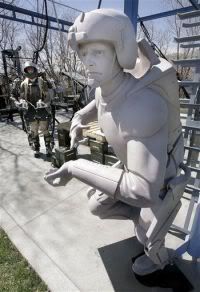RE: Robotic Suit could usher in Super Soldier Era
From: Support the US Terrorists! (Free the Enemy)
Date: May 17, 2008 2:56 PM
The Singularity

By MARK JEWELL, AP Business Writer
Software engineer Rex Jameson, wearing a robotic soldier suit being made for the U.S. Army by Raytheon, poses next to a mockup statue of a future soldier on Monday, April 14, 2008, in Salt Lake City. The suit can multiply its wearer's strength and endurance as many as 20 times, with relatively little loss of agility, by sensing and almost instantly amplifying every movement the wearer makes. (AP Photo/Douglas C.
Pizac)
(AP) -- Rex Jameson bikes and swims regularly, and plays tennis and skis when time allows. But the 5-foot-11, 180-pound software engineer is lucky if he presses 200 pounds - that is, until he steps into an "exoskeleton" of aluminum and electronics that multiplies his strength and endurance as many as 20 times.
With the outfit's claw-like metal hand extensions, he gripped a weight set's bar at a recent demonstration and knocked off hundreds of repetitions. Once, he did 500.
"Everyone gets bored much more quickly than I get tired," Jameson said.
Jameson - who works for robotics firm Sarcos Inc. in Salt Lake City, which is under contract with the U.S. Army - is helping assess the 150-pound suit's viability for the soldiers of tomorrow. The suit works by sensing every movement the wearer makes and almost instantly amplifying it.
The Army believes soldiers may someday wear the suits in combat, but it's focusing for now on applications such as loading cargo or repairing heavy equipment. Sarcos is developing the technology under a two-year contract worth up to $10 million, and the Army plans initial field tests next year.
Before the technology can become practical, the developers must overcome cost barriers and extend the suit's battery life. Jameson was tethered to power cords during his demonstration because the current battery lasts just 30 minutes.
But the technology already offers evidence that robotics can amplify human muscle power in reality - not just in the realm of comic books and movies like the recently debuted "Iron Man," about a wealthy weapons designer who builds a high-tech suit to battle bad guys.
"Everybody likes the idea of being a superhero, and this is all about expanding the capabilities of a human," said Stephen Jacobsen, chief designer of the Sarcos suit.
The Army's exoskeleton research dates to 1995, but has yet to yield practical suits. Sarcos' technology sufficiently impressed Raytheon Co., however, that the Waltham, Mass.-based defense contractor bought Sarcos' robotics business last November. Sarcos also has developed robotic dinosaurs for a Universal Studios' "Jurassic Park" theme park ride.
Jack Obusek, a former colonel now with the Army's Soldier Research Development and Engineering Center in the Boston suburb of Natick, foresees robot-suited soldiers unloading heavy ammunition boxes from helicopters, lugging hundreds of pounds of gear over rough terrain or even relying on the suit's strength-enhancing capabilities to make repairs to tanks that break down in inconvenient locations.
Sarcos' Jacobsen envisions factory workers someday using the technology to perform manual labor more easily, and firefighters more quickly carrying heavy gear up stairwells of burning buildings. Disabled people also may find uses for the technology, he said.
"We see the value being realized when these suits can be built in great numbers for both military and commercial uses, and they start coming down in cost to within the range of the price of a small car," said Jacobsen. He declined to estimate how much the suit might cost in mass production.
But cost isn't the only obstacle. For example, developers eventually hope to lengthen the suit's backpack battery's life and tinker with the suit's design to use less energy. Meanwhile, the suit can draw power from a generator, a tank or helicopter. And there are gas engines that, while noisy, small enough to fit into the suit's backpack.
"The power issue is probably the No. 1 challenge standing in the way of getting this thing in the field," Obusek said.
But he said Sarcos appears to have overcome the key challenge of pairing super-fast microprocessors with sensors that detect movements by the body's joints and transmit data about them to the suit's internal computer.
Much as the brain sends signals to tendons to get muscles to move, the computer sends instructions to hydraulic valves. The valves mimic tendons by driving the suit's mechanical limbs, replicating and amplifying the wearer's movements almost instantly.
"With all the previous attempts at this technology, there has been a slight lag time between the intent of the human, and the actual movement of the machine," Obusek said.
In the demonstration, the bulky suit slowed Jameson a bit, but he could move almost normally. When a soccer ball was thrown at him, he bounced it back off his helmeted head. He repeatedly struck a punching bag and, slowly but surely, he climbed stairs in the suit's clunky aluminum boots, which made him look like a Frankenstein monster.
"It feels less agile than it is," Jameson said. "Because of the way the control laws work, it's ever so slightly slower than I am. And because we are so in tune with our bodies' responses, this tiny delay initially made me tense.
"
Now, he's used to it.
"I can regain my balance naturally after stumbling - something I discovered completely by accident.
"
Learning was easy, he said.
"It takes no special training, beyond learning to relax and trust the robot," he said.
http://physorg. com/news130078697. html
********************************
thanks earthica*star
go here.. you wont believe Albert Einstein...
http://video. google. com/videoplay?docid=6886366684642645815&q=hanson+robot&total=44&start=10&num=10&so=0&type=search&plindex=0
http://www. wordinfo. info/words/index/info/view_unit/4227/?letter=B&spage=3
link for article below...
http://wordinfo. info/words/index/info/view_unit/3719/?letter=a&page=1&spage=1&s=can
iRobot's PackBot on the front lines
Almost three years into the Iraq conflict and four into the Afghanistan war, the phrase "improvised explosive devices" (IEDs) has become one that is met with hesitation. This is a new style of combat that's still being studied, and in the mean time, a good scouting technology that can effectively scout a given area and not place troops at risk has yet to be developed.
Enter the PackBot, a fourty-four pound unit being developed by iRobot (makers of the popular Scooba and Roomba robotic floor cleaning devices) which may help save lives as these conflicts continue. The PackBot, which retails at approximately $100,000 per unit, is a squat, rectangular robot, complete with heavy treaded wheels on its right and left sides. These treads are complimented by movable "flipper" appendages that can be individually moved to provide additional traction.
The unit can grip the edges of a staircase it may be climbing or descending. An internal gyroscopic system reading pitch and roll coordinates shifts the unit's weight where it needs to be.
Controlled by a console stored in a rugged 30-pound metal case, operators swing open the case, screw in two antennas and begin to control the camera and sensor-laden PackBot via a radio or fiber optic connection. The software, powered by a BlueCat linux operating system, allows users access to the PackBot's sensor and tool arrays, which include systems for measuring voltages, currents, internal temperatures, GPS locations and overall positioning. The unit can also include an extendable arm, tactile claw to pick up and handle objects, up to eight cameras and chemical sensors that help to locate improvised explosive devices.
"They're fearless," said Joseph Dyer, executive vice president and general manager of iRobot's Government and Industrial Robotics division. Dyer then cited the idea of tactical speed with the PackBot. While the unit may not win the speed race at five to six miles per hour, it can easily enter into locations soldiers would approach with caution.
iRobot's PackBot on the front lines
In circumstances where it would be dangerous to blindly enter a building, a PackBot can be thrown through a window, unfold itself and be deployed as a remotely controlled scout. The PackBot, which can constrict into a 24 inch space, has been sent into operations in Iraq and Afghanistan with over 300 units in action and a current contract extending to provide 1,200 units more of the model. The unit was first put into use as a search tool after the September 11, 2001 attacks and became widely utilized as a search tool during the Afghanistan cave hunts for Taliban fighters.
Given certain situations, the presence of a robotic unit seemed more comforting than anything a human could offer. In one case with a despondent person holding himself hostage, the PackBot, which is also equipped with a Voice over Internet Protocol communication system that can both transmit and receive audio messages, became something the person felt comfortable speaking with. After a period of time, the person asked for the robot to bring him a telephone and later a cup of coffee, which had been drugged and rendered the subject unconscious to end the situation.
Training for the PackBot currently entails about 1.5 days worth of training before basic proficiency is reached. Within a few weeks, operators have typically figured out settings and maneuvers that work best with what they're trying to accomplish.
Video game generation seems to learn how to operate the robots quickly
In addition to bomb disposal and remote work, the PackBot can also be used as a scout unit. A PackBot, or several, can be sent into a hostile environment; such as, a building that might be used as a refuge for insurgency forces. The PackBot, using a laser scanner or other device, can create a three dimensional map of the building for later use. Multiple units, if sent traveling through sections, can divide the workload among themselves for a faster scan.
The PackBot, which is being developed by iRobot in conjunction with the military's DARPA (Defense Advanced Research Project Agency) program, is part of a $50 million Future Combat System contract to develop a robot under 30 pounds for deployment. The ultimate mission of these machines is to save lives.
—Excerpts from an article by Chris Barylick, UPI Technology Correspondent
are robots afraid to go to war?
Labels: The Truth Is Out There
 Dear Hillary,
Dear Hillary,






